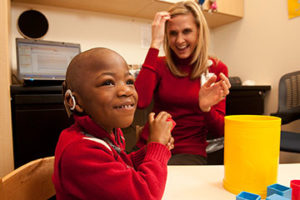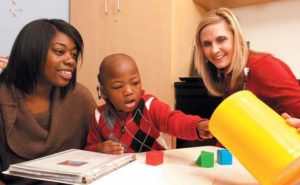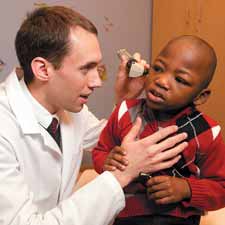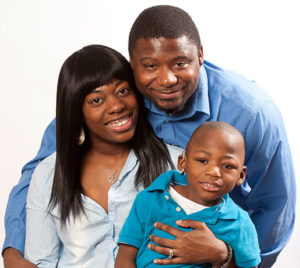Our Patients:
Bryson May

Bryson May has been a Cardinal Glennon Kid since his birth in 2007. He was born prematurely, weighing just less than 2 pounds, and spent seven months in neonatal intensive care. He underwent heart surgery and had difficulty breathing because his lungs were very small and he contracted pneumonia. The complications of his extreme prematurity and life-saving treatments left him with cerebral palsy and a profound hearing deficit.
Today Bryson is learning to get around with his walker. And he is hearing, speaking and using sign language thanks to a cochlear implant he received at SSM Health Cardinal Glennon Children’s Hospital.
During Bryson’s infancy, “His hearing screenings always came back bad,” says his mother, Vernique May. “They thought he might have an ear infection, so they treated it with antibiotics. After a couple of runs of antibiotics they did a deeper test and found that he had a profound hearing loss. They started trying hearing aids, but the hearing aids didn’t prove to be strong enough to help him.”
The hearing deficit made Bryson’s first two years of life frustrating for him and his parents, Vernique and Eric May.
“When he tried to communicate, we didn’t know what he was trying to tell us,” his mother says. “We had to guess at what he wanted. If he wanted juice and we gave him a cracker, you can imagine how frustrating that had to be.”
Testing at SSM Health Cardinal Glennon indicated that Bryson would be a good candidate for a cochlear implant, an electronic device that creates the sensation of sound for people with severe hearing deficits. About 30,000 children in the U.S. have received them.
“One of a thousand children is born with a hearing loss. Fewer children than that are candidates for cochlear implants,” says Dary Costa, MD, one of two pediatric otolaryngologists at SSM Health Cardinal Glennon who care for children with cochlear implants.
The implant consists of two devices. A receiver-stimulator is surgically placed under the skin behind the ear. A tiny electrode array extends from the receiver into the ear’s cochlea, where the auditory nerve normally produces hearing.
The device’s outer section, held in place by a magnet and earpiece, contains a microphone and a processor that filters and organizes sounds. The sounds are converted to electronic impulses that are transmitted through the skin by radio waves. The receiver under the skin sends the signals to the auditory nerve.
The result is not normal sound, says Costa, a Saint Louis University assistant professor of otolaryngology. “It is difficult to say how the sounds that Bryson hears compare to what we hear. Adults who have lost their hearing and then received a cochlear implant describe the sound as robotic. Otherwise, they say they appreciate sound, and occasionally music, to a level similar to what they had before.”
The receiver of Bryson’s implant was surgically placed in November 2009 by Anthony Mikulec, MD, director of otology and neurotology at SSM Health Cardinal Glennon and Saint Louis University School of Medicine. This procedure typically requires about three hours in the operating room.
On Dec. 4, 2009, Bryson’s implant was activated. Implant activation can come as a shock to children who have never heard a sound.
“Once he calmed down and got over hearing himself scream and cry, he was intrigued by all the stuff he was hearing,” Vernique says. “A lot of the noise that we don’t pay any attention to, like cups clanging in the dishwasher, overwhelmed him initially. It was scary for him.”
After a few weeks, “He got used to it. If his receiver falls off now, he points to his head. He realizes it needs to be a part of him so he can hear,” she says.
Children with cochlear implants continue to visit their audiologists. “We put them in a sound booth and connect their implant to a computer,” says Sarah Duncan, M.S.CCC-A, lead audiologist at SSM Health Cardinal Glennon.
“The computer plays certain sounds and beeps so we can see how the child responds. We program the implant to match their ability to hear the sounds.” Bryson and other children with cochlear implants continue receiving therapy to assist them in understanding sound and learning to speak.
“The first three years of life are vital for speech development,” Duncan says. “Bryson has responded beautifully. He has jumped leaps and bounds from the moment we met him in 2009.”
A cochlear implant will be provided this year to an SSM Health Cardinal Glennon patient whose family does not have the resources to pay for the surgery and therapy. A grant from The Variety Club the Children’s Charity of St. Louis will pay for a portion of the implant. Private donations to Cardinal Glennon Children’s Foundation will cover remaining costs. In addition, two children received cochlear implants in 2011 thanks to generous gifts from donors.
Bryson receives some of his speech therapy at his school and continues to visit SSM Health Cardinal Glennon for implant programming. “Bryson knows his numbers and his colors and can say ‘mommy’ and ‘daddy,’ says Vernique. “He loves watching his DVDs and signing along. A lot of words he says are very clear. Some are not. He needs more speech pathology, but his therapists don’t seem to have huge doubts about his progress. They say he is on target.”
After Bryson’s discharge from SSM Health Cardinal Glennon’s Dana Brown Neonatal Intensive Care Unit, Vernique spent two years as a unit secretary at the medical center.
“I’m still very close to a lot of the staff here,” she says. “Cardinal Glennon is like a home away from home for us.”


